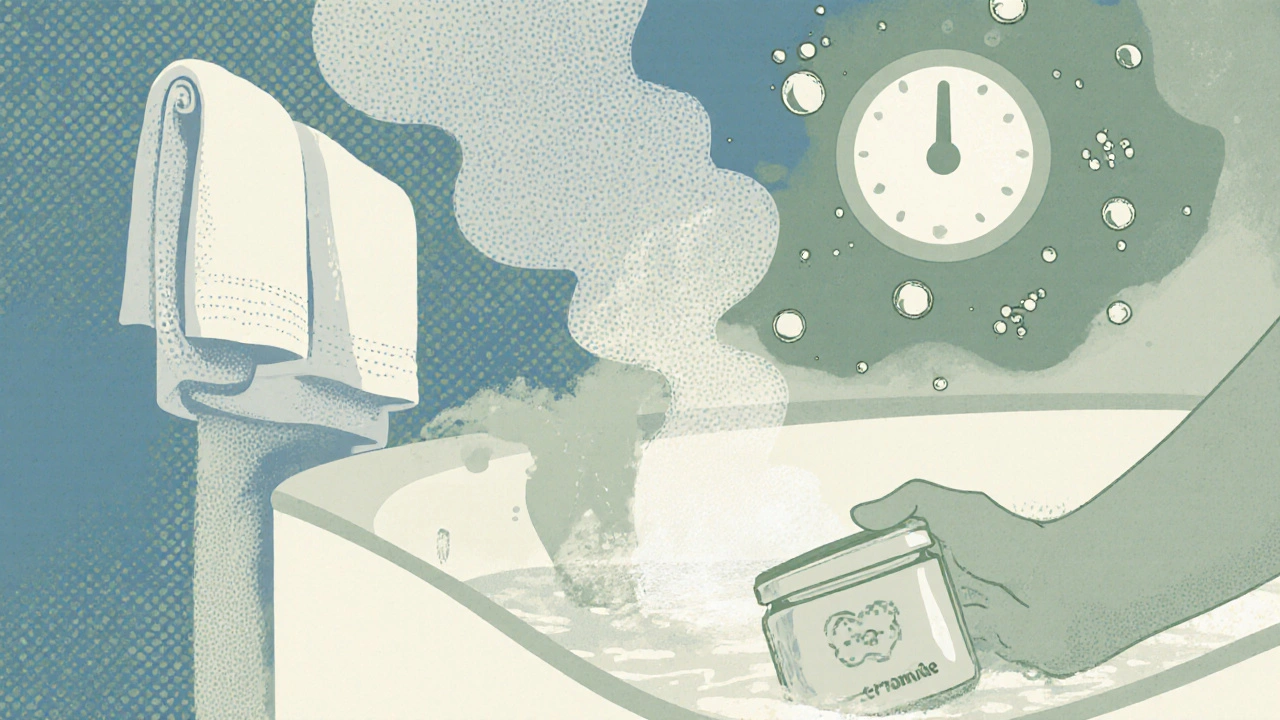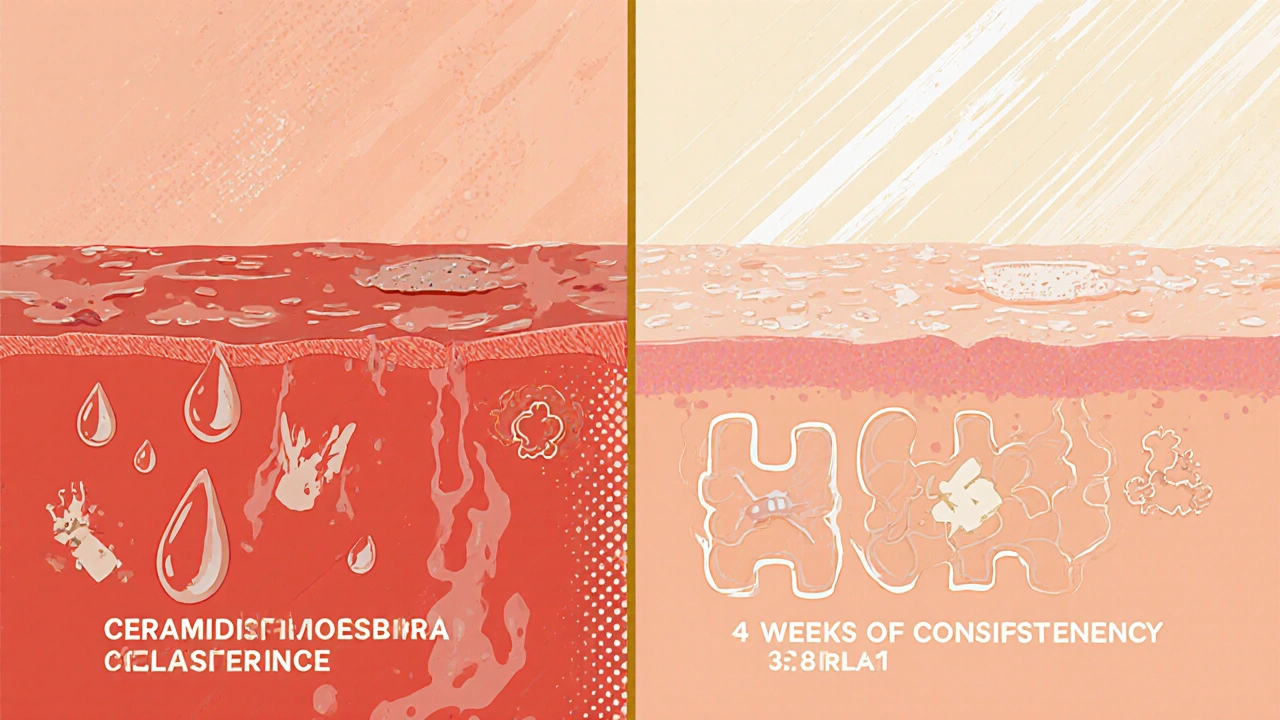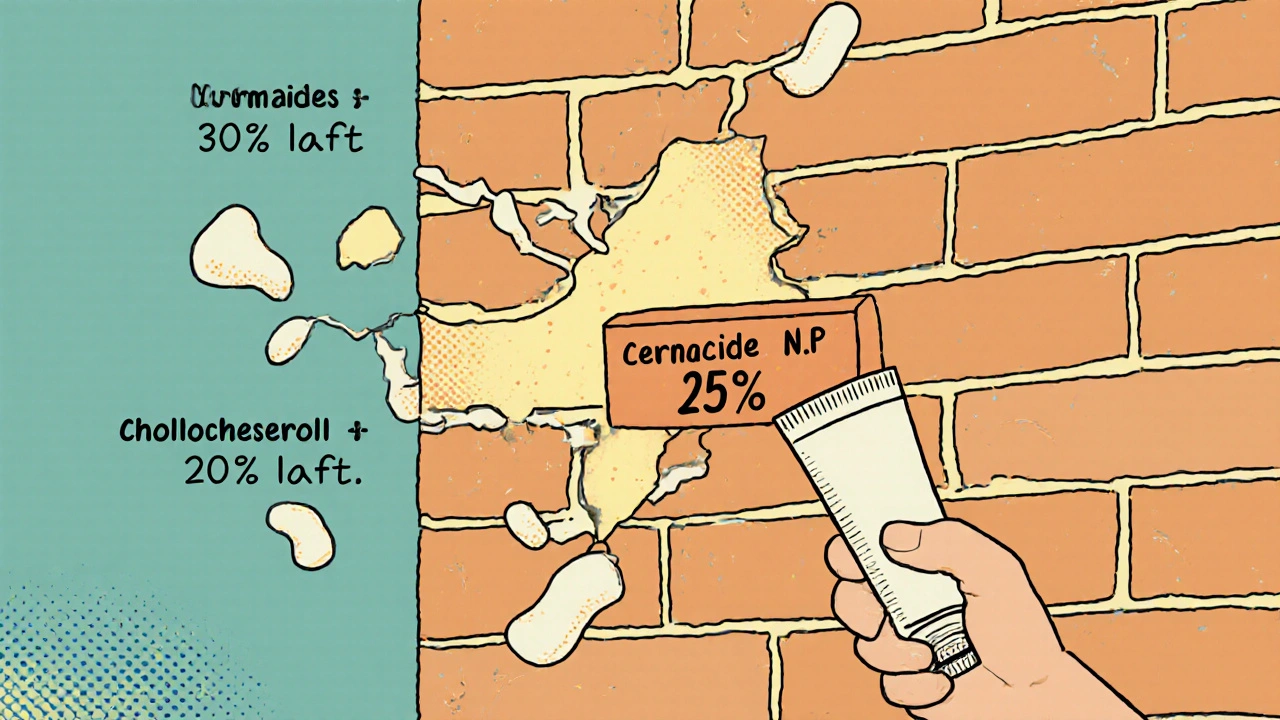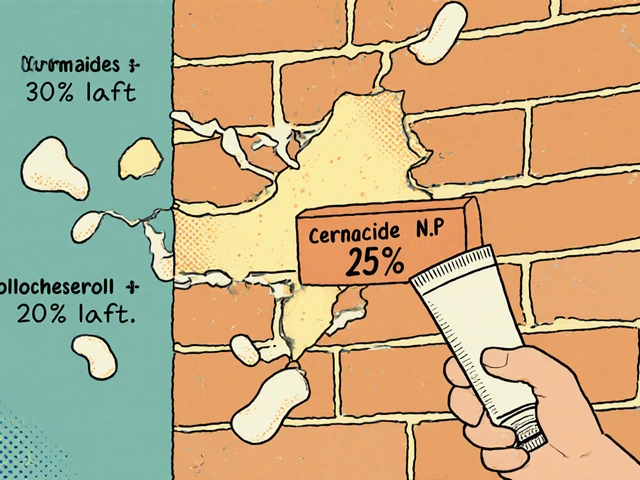Why Your Eczema Won’t Improve (Even With Moisturizer)
Many people with eczema spend hours applying lotions, creams, and ointments-only to see no real change. The problem isn’t that they’re not trying hard enough. It’s that most products don’t fix the real issue: a broken skin barrier. Eczema isn’t just dry skin. It’s a damaged wall that lets moisture escape and irritants in. And the key to fixing it isn’t just hydration-it’s ceramides.
The skin’s outer layer, called the stratum corneum, works like a brick-and-mortar wall. The bricks are dead skin cells. The mortar? A mix of lipids-mostly ceramides (50%), cholesterol (25%), and fatty acids (15%). In healthy skin, these are in a perfect 3:1:1 ratio. In eczema? That ratio is shattered. Ceramide levels drop by 30-50%, and the types of ceramides shift toward weaker, shorter-chain versions. The result? Water leaks out. Irritants sneak in. Inflammation flares up. Transepidermal water loss (TEWL) jumps 40-60% compared to normal skin.
What Ceramides Actually Do (And Why Most Moisturizers Fail)
Ceramides aren’t just another ingredient. They’re the glue holding your skin barrier together. They form long, interlocking chains that seal in moisture and block allergens, bacteria, and chemicals. When you use a regular moisturizer-like petrolatum-based creams-you’re only adding a temporary film. It slows water loss, but it doesn’t rebuild the wall.
True barrier repair needs the full lipid trio: ceramides, cholesterol, and fatty acids-in the exact 3:1:1 ratio. Products that only add ceramides alone can actually make things worse by disrupting the balance. Clinical studies show that incomplete formulations delay recovery by 15-25%. That’s why prescription barrier creams like EpiCeram® and TriCeram® work. They don’t just moisturize-they restore.
Over-the-counter products like CeraVe have brought ceramides to the masses, but not all are created equal. Many contain too little ceramide or the wrong types. A 2021 review in Cells found that physiological ceramide formulations repair the barrier 40% better than traditional petrolatum creams. If your moisturizer doesn’t list specific ceramide types (like Ceramide NP, AP, or EOP), it’s likely just masking symptoms-not fixing the root problem.
The Right Way to Bathe (It’s Not What You Think)
Bathing can either help or hurt your eczema. Hot showers, long soaks, and harsh soaps strip away what little lipid protection you have left. The key? The soak and seal method.
- Use lukewarm water-no hotter than 90°F (32°C). Hot water breaks down lipids and dries skin faster.
- Limit baths to 10-15 minutes. Longer doesn’t help-it harms.
- Use a fragrance-free, pH-balanced cleanser (pH 5.5). Avoid anything with sodium lauryl sulfate above 0.5%. Higher levels spike TEWL by 25-40% in just one hour.
- Pat skin dry-not rub. Leave it slightly damp.
- Within 3 minutes, apply your ceramide cream. Wet skin absorbs 50-70% more of the active ingredients.
This simple routine doubles the effectiveness of your moisturizer. Skipping the damp-step is one of the biggest mistakes people make. Waiting even 10 minutes after bathing cuts absorption dramatically.

How Long Until You See Results?
Don’t expect overnight changes. Ceramide-based repair is slow, but lasting. Topical steroids can calm redness in 3-7 days. Ceramides take 3-4 weeks. That’s because they’re rebuilding your skin’s structure, not just suppressing inflammation.
Studies show visible improvement in 21-28 days. By week 6, most users report less itching, fewer flares, and reduced need for steroids. One case in the Dermatology Online Journal showed a patient cutting steroid use from daily to once a week after 8 weeks of consistent ceramide use. Their SCORAD score-a measure of eczema severity-dropped from 42 to 18.
Patience is critical. If you stop too soon, the barrier starts breaking again. Consistency is the real treatment.
Prescription vs. Over-the-Counter: What’s Worth the Cost?
Prescription ceramide creams like EpiCeram® and TriCeram® are expensive-$25-$35 for a 200g tube. OTC versions like CeraVe cost $5-$15. Is the price difference worth it?
For mild eczema, CeraVe works well. It contains ceramides, cholesterol, and fatty acids in a near-physiological ratio. Many users report less itching and fewer flares. But for moderate to severe eczema, prescription products deliver stronger results. Clinical trials show TriCeram® improves skin hydration 30% more and clears redness 25% faster than standard moisturizers.
Also, prescription products are regulated as medical devices (FDA Class II). That means they must prove they restore the barrier-not just feel nice. OTC products only need to be safe. They don’t have to prove they fix the problem.
And here’s the catch: insurance rarely covers them. Only 42% of U.S. commercial plans pay for prescription barrier creams. That leaves many patients paying out of pocket.
What Real People Say (And What They Wish They Knew)
On Reddit’s r/eczema community, 78% of users who tried ceramide creams reported major improvements in dryness and itching within 2-4 weeks. One user wrote: “After trying 10+ moisturizers, EpiCeram reduced my nightly scratching from 8-10 times to 1-2.”
But complaints are common too. The top three? Greasy texture (27%), slow results (15%), and cost (19%). One WebMD reviewer said: “Great for maintenance, but useless during bad flares-I still needed my steroid cream.” That’s true. Ceramides aren’t for acute flares. They’re for long-term repair. Use steroids to calm the fire. Use ceramides to stop the next one.
Another frequent mistake: applying ceramide cream only once a day. Experts recommend twice daily. During flares, go to three times. Many users give up because they don’t apply enough or often enough.

What’s Next in Barrier Repair?
The future of eczema treatment is getting smarter. Researchers are now developing biomarker-guided ceramide creams. Imagine a test that shows you’re low in Ceramide 1-then your moisturizer is customized to replace exactly what’s missing. LEO Pharma is already testing this in Phase II trials, with early results showing 30% better outcomes in patients with specific ceramide deficiencies.
Delivery tech is improving too. Multi-vesicular emulsions (MVE) now deliver ceramides 45% deeper into the skin than old formulations. New pump dispensers reduce waste by 22%. And in 2023, the European Academy of Dermatology upgraded its guidelines to recommend ceramide emollients for all severities of eczema-not just mild cases.
Dr. Thomas Bieber from the University of Bonn predicts that within five years, choosing the right barrier repair product will be as routine as picking a biologic for severe eczema. The science is clear: repair the barrier, and you stop the cycle.
Bottom Line: What You Need to Do Today
- Stop using harsh soaps. Switch to a gentle, pH-balanced cleanser.
- Bathe in lukewarm water for 10-15 minutes max.
- Apply ceramide cream within 3 minutes of getting out of the bath.
- Use it twice daily-morning and night. Add a third application during flares.
- Don’t expect instant results. Give it 4-6 weeks.
- If you have moderate to severe eczema, consider a prescription ceramide cream like EpiCeram® or TriCeram®.
- Remember: ceramides don’t replace steroids during flares-they replace the need for them over time.
The skin barrier isn’t just a layer. It’s your first line of defense. Fix it right, and eczema stops being a daily battle. It becomes something you manage-not something that controls you.
Can I use ceramide cream every day?
Yes. Ceramide creams are safe for daily, long-term use. Unlike steroids, they don’t thin the skin or cause side effects with regular use. Most dermatologists recommend applying them twice a day, morning and night. During flares, increase to three times daily.
Are all ceramide moisturizers the same?
No. Many OTC products contain low concentrations or only one type of ceramide. Effective barrier repair requires a full blend: ceramides, cholesterol, and fatty acids in a 3:1:1 molar ratio. Look for products that list specific ceramide types (like Ceramide NP, AP, or EOP) and include cholesterol and fatty acids. Prescription creams like EpiCeram® and TriCeram® are formulated to meet this standard.
Why does my skin feel tight after using ceramide cream?
Some users report a temporary tight or taut feeling during the first week. This isn’t irritation-it’s your skin adjusting. As the barrier rebuilds, it pulls back into shape. This sensation usually fades after 7-10 days. If it turns into stinging or redness, stop and check the product for allergens like fragrances or preservatives.
Can ceramides cure eczema?
Ceramides don’t cure eczema-it’s a chronic condition. But they do stop the cycle of damage and inflammation by restoring the skin’s natural barrier. Many people find they need fewer steroids, have fewer flares, and experience longer periods of calm skin. Think of ceramides as maintenance, not a cure.
Is bathing bad for eczema?
Not if done right. Long, hot showers with harsh soaps are harmful. But a short, lukewarm bath with a gentle cleanser followed by immediate moisturizing is one of the most effective ways to repair the barrier. The key is timing: apply ceramide cream within 3 minutes of getting out of the water.
What to Try Next
If you’re using a basic lotion and still having flares, switch to a ceramide-based moisturizer with cholesterol and fatty acids. Start with an OTC option like CeraVe Healing Ointment or Eucerin Advanced Repair. If you don’t see improvement in 4 weeks, talk to your dermatologist about prescription options. And don’t forget the bath routine-it’s the foundation of everything else.



Yvonne Franklin
November 24, 2025 AT 00:29Stop chasing miracle creams. Fix the barrier.